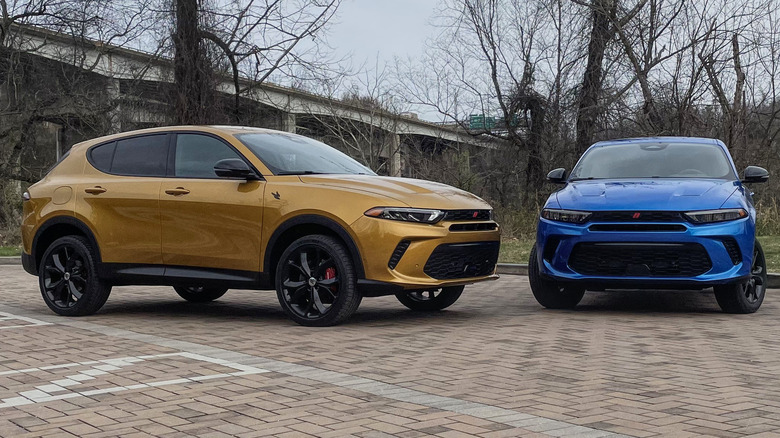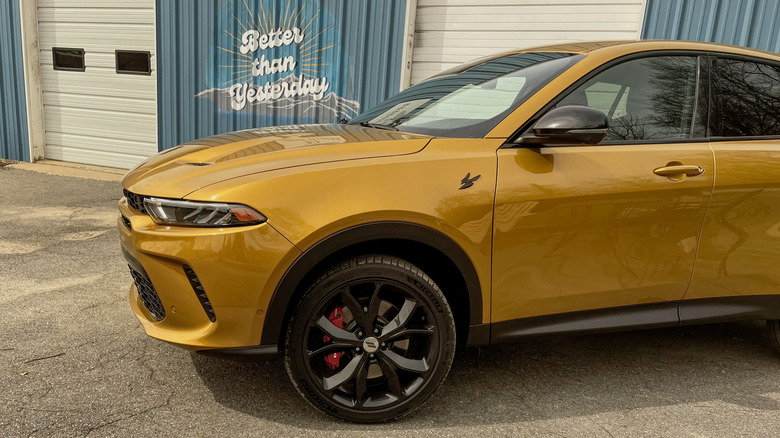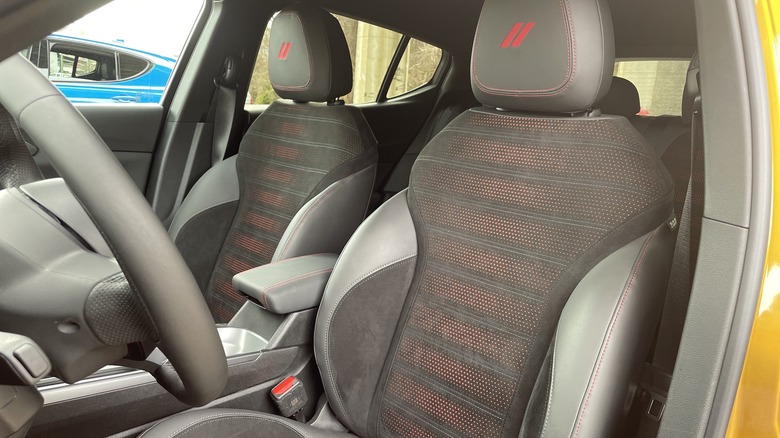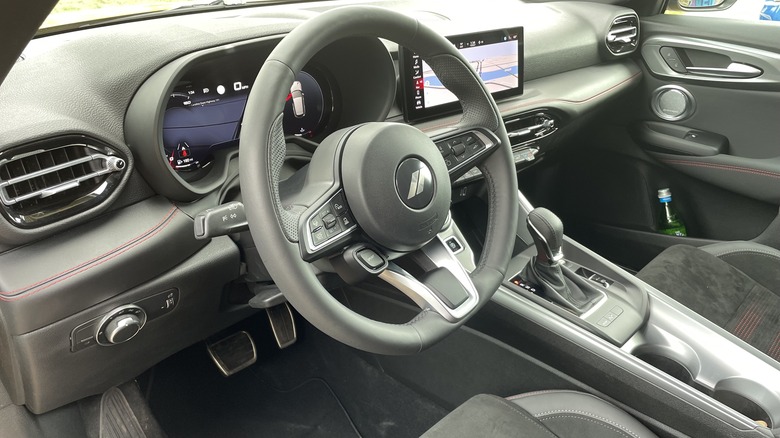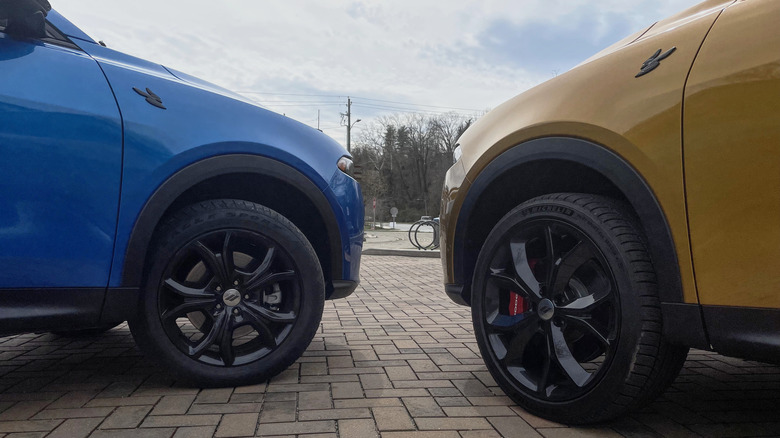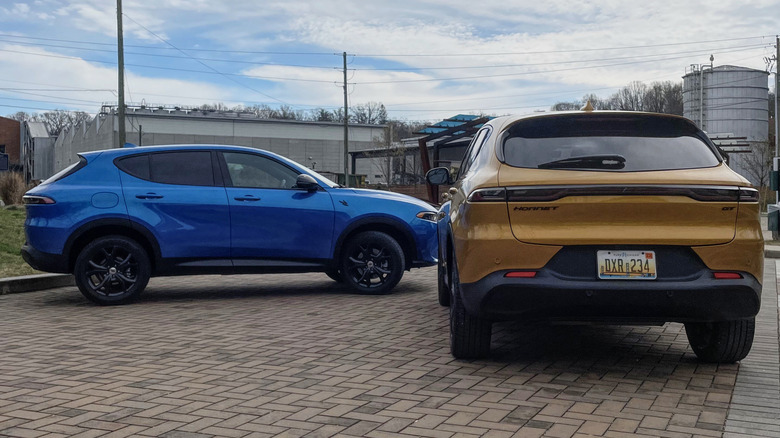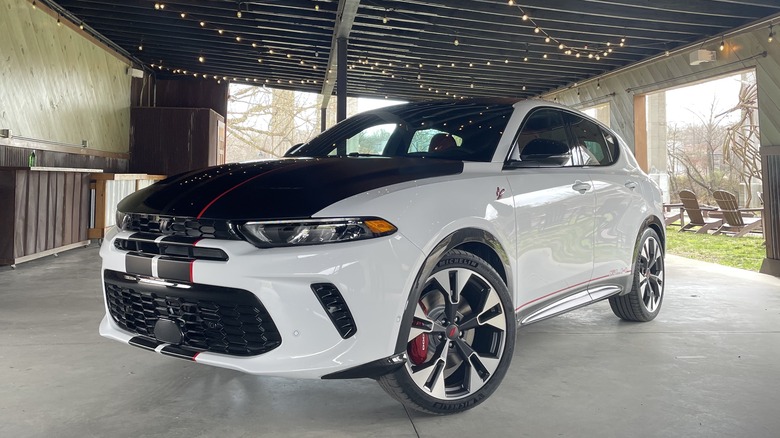2023 Dodge Hornet First Drive: When All I Want From You Is To Sting Me
Dodge's muscle cars, the Charger and Challenger, are on their way out, after long and storied histories as bold, brash, brightly-colored behemoths. Without a plan to move forward, that would leave only the Durango, in its advanced age, taking responsibility for the future of the brand. Even Dodge knows a 10-year-old cousin of the Grand Cherokee can't handle that kind of burden, so this injection of new energy comes just in time.
The Hornet name has adorned a bunch of cars in its time: first Hudson, then AMC. Dodge showed a Hornet hot hatch/MPV concept back in 2006, and though this new vehicle looks nothing like it, we appreciate the effort at continuity. In keeping with the times, it's a crossover — a mass-market version of the Alfa Romeo Tonale, which makes sense in the way that most things Stellantis make some sense. Like all automakers, Dodge needs to draw in younger buyers, and a cute, colorful 'ute is a smart if predictable choice.
Predictable until you get behind the wheel, that is. The prick of the new Dodge Hornet leaves a mark, and this venom is going to spread until the brand has changed completely. Here's what we learned about Dodge's new crossover on and around some of the country's most glorious driving terrain, the ridges of North Carolina.
Carrying a torch
For what it's worth, Dodge has always carried well-deserved street cred for slapping together an attractive paint palette — even when the Charger and Challenger looked dated (classic, but dated!), the colors never failed to flatter. Why so many other automakers shy away from color when Dodge embraces it wholeheartedly — well, people don't buy colors, those automakers would explain — except, apparently, for the people who buy Dodges. We're glad to see that, at least, hasn't changed.
The Acapulco Gold and Blue Steele examples on display during the press briefing showed the Hornet in its best light. From a distance, it'll be hard to tell a Hornet from any other compact crossover, especially considering it's burdened with the same contrast trim as most of its rivals (matte black on the GT and dark gray gloss on the R/T) with no option for body color, at least for the time being.
Dodge designers concentrated the aggression up front, with what they called a "sneaky aero profile" (translation: plenty of space dedicated to air intakes) and overall a bit more bite than you'd expect to find on most other compact utility vehicles. It's tougher-looking than any of the true hot hatches that allegedly inspired the Hornet, in any case, with clear design cues borrowed from the Charger and Challenger.
That said, the coolest thing about the Hornet's exterior, besides the colors, is the awesome little Hornet emblem on the fenders, cheekily showing off its stinger. Dodge does emblems well, too. The rear lighting cuts a thin line across the liftgate, flanking an illuminated Dodge logo in the middle, which is also really cool-looking when you're behind one in traffic.
The nest
The Hornet's base interior is on the blah side — perfectly comfortable, but monochrome and minimalist in a way that works in a Challenger but might not translate well for, say, the wife, or college kid, of a Challenger driver. It's clearly the compromise Dodge had to make to hit the Hornet's sub-$30k price point and for that it's fine. Just know that if you're buying a Hornet, you're probably going to want to upgrade for better seats and upholstery.
It would hardly be a Dodge without an overwhelming red upholstery scheme on offer, but we prefer the black perforated Alcantara with a red base layer, a much more subtle variation on the theme. It's included with the Track Pack on both trim levels.
The overall layout is smart, with displays angled toward the driver, and screens that are configurable in a number of different ways. The normal theme puts the gauges at the forefront, but they can be downsized or minimized so you can focus on whatever you want. There's a bit of a learning curve — we found it a bit too easy to tap the wrong steering wheel button and find ourselves frantically looking for nav information and, in one case, the speedometer — but after a bit of initial tinkering, even the "set-it-and-forget-it" types should be satisfied.
Wireless Apple CarPlay and Android Auto come standard, and the infotainment system can connect to two phones and switch between them with a single tap. The other system worth playing with is the Drive Mode Explorer, which shows how the car's current drive mode (Sport, eco/EV, etc.) affect the car's automatically adjusted settings for that mode (such as suspension and throttle).
The GT: ICE ICE baby
The base Hornet GT is surprisingly and delightfully affordable, and you'll like it just fine if you don't make the mistake of driving the R/T first. It yields 268 hp and 295 lb-ft of torque from its 2.0-liter turbo engine, and it comes standard with all-wheel drive and a smooth nine-speed automatic gearbox. It's peppy, perky, and planted; it's what we want from a hot hatch, even though it's hard not to feel a hit of nostalgia for the fact that a new car like this is never going to have a manual transmission ever again.
Some of the active driving assistance (or advanced safety technology, if you prefer) are fresh to the Dodge brand, but they won't be unfamiliar to anyone who's driven a new car in the past few years. These safety nannies are relatively intuitive, straightforward, and easy to use; they're also easy to turn off if they're getting in the way. That said, it's hard to scoff at some of those sensors or claim they're unnecessary the way you would if you were buying, say, a muscle car — the Hornet's exterior design looks good, but those chunky hatch haunches create a blind spot the size of a Durango.
Here's the main thing about the GT: it's a decent car and a fun drive. It doesn't struggle for power in normal driving scenarios. However, it does show how much the Hornet benefits from electrification... and maybe a little bit of what Dodge was missing by declining to electrify the Charger and Challenger all these years.
The R/T: gotta wait for the charge
The R/T is the better of the two Hornets in every measure except for one — the GT is on sale now, and the R/T is going to come later as a 2024 model.
This Hornet trim makes 288 hp and 383 lb-ft from a 1.3-liter turbocharged plug-in hybrid powertrain, and every drop of it is a delight, from the 30-or-so-mile fully-electric range to the e-AWD system. It doesn't have that much more horsepower than the GT, but that torque makes all the difference in the world in driving dynamics. What a fun little thing, quick and smooth.
Brembo front brakes quickly bring the R/T to a stop and dress up the front wheels. Koni suspension comes standard, and there's an available dual-stage suspension that adjusts in Sport mode. Dodge notes this is a "real" Sport mode that actually changes the shift points and steering calibration, instead of just faking it for effect. The R/T's regenerative braking, which can add range back to the battery, is linked to the drive mode, so its effect on driving dynamics blends into the overall experience, even when the energy regeneration itself might suffer for it somewhat.
The R/T gets EV modes to manage its electric range and hybrid system, and there's also the PowerShot feature in Sport mode, which summons a temporary 30 hp from the rear electric motor. It's like a launch mode, except you use it when you're already moving. We found it a little finicky with a complex sequence of steps to activate, but it's a fun feature and makes the Hornet truly feel like a Dodge despite the feature being available purely as the result of a PHEV system. Again, it stings that the brand's outgoing muscle cars missed this shot.
Pricing and availability
It'll be a while before you can get a charged Hornet. The 2023 Dodge Hornet GT is on sale now, with an MSRP of $29,995 for the Base and $34,995 for the Plus. The R/T will debut as a 2024 model, with anticipated pricing of $39,995 in Base trim and $44,995 for the Plus. Dodge notes that, if you're interested in leasing a 2024 Hornet R/T when it becomes available, the $7,500 federal tax credit may apply. Keep in mind that Dodge recommends premium fuel for both models, but says that you can get away with 87 in the GT.
At the time of writing, only the black (8 Ball) and white (Q Ball) exterior colors are no-cost options. Gray Cray, Blu Bayou, and Hot Tamale are each $495, while Blue Steele and Acapulco Gold are $595.
Dodge says that all four of its content packages — Plus, Blacktop, Track Pack, and Tech Pack — will be available on both trims, so the Hornet's optional content won't be locked behind a paywall. At the time of writing, pricing for the GT Blacktop Package was $1,995, Track Pack was $2,995, and the Tech Pack (minus parking assists) cost $2,245. Dodge notes that the Blacktop package, which adds blacked-out trim and upgraded wheels, has a high take rate on the brand's other models, and that the Track Pack, with its upgraded suspension, Alcantara upholstery, 20-inch alloys, and sporty aesthetic upgrades, was specifically designed to be affordable across the lineup.
Hornet outta hell
Here's why Dodge keeps making "hot hatch" references in relation to the Hornet — though it's clearly a crossover, the Hornet will eventually mark the return of Dodge's GLH, or "goes like hell" moniker. We saw a preview of the Hornet GLH, which gets the cute initials in side decals, an exclusive two-tone version of the Hornet emblem, racing stripes — it's actually pretty '80s, in an endearing way, and it will be available to dress up both GT and R/T models. It's not all costume, either: the GLH will ride a little lower on an upgraded suspension, and a performance exhaust will provide a boost.
If you're too young to be familiar with the GLH, that's fine, because honestly Dodge must be counting on that for a not-insignificant proportion of the Hornet's target audience. Remember the Dodge Omni, even vaguely? A tiny hatchback nearly indistinguishable from the Volkswagen Rabbit? Well, it could be equipped to Go Like Hell, even if it was prepped for the trip with Bondo and zip ties.
We don't see that nostalgia specifically responsible for selling a lot of Hornets, but it's fun nonetheless, and the faux-edginess of GLH fits with the brand image even as the Charger and Challenger and Hellcats are phased out. Dodge's Mopar factory performance division is making a proper return, too, and none too soon: the Hornet GLH will be a perfect canvas for its aesthetic accessories and bolt-on performance upgrades. In short, the muscle cars Dodge has relied upon for so long may be leaving us, but Stellantis' feistiest brand isn't letting their spirit die with them.
